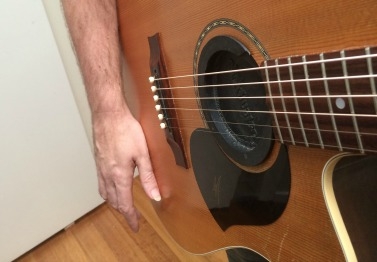Octave harmonics and alternate/open tunings were the two approaches covered in part 1 of how to reignite your creativity with your acoustic guitar playing. In part 2, a further three cool and unique approaches will be introduced that'll give you endless amounts of inspiration and motivation with your playing.
When you look at it, your acoustic guitar is nothing more than a wooden box with some strings, so in addition to playing it melodically why not play it percussively too.
This ever increasingly popular way to approach playing acoustic guitar is a lot of fun and sounds great with just a few of the fundamentals under your fingers. No need for years of practice at all before sounding any good. You'll wonder why you never thought of playing your acoustic in this way before. The creative potential of this style alone is massive to say the least.
Here is an example of some percussive playing integrated into a simple chord progression to get you on your way:

* You will find the percussive hits in the progression above in the drum stave. This is often used when it comes to notating percussion for guitar.
I am hitting the lower area of the sound board of the guitar, on the frontside just below the bridge, with the side of my picking hand thumb to get a kick drum sound (see picture for reference). This is indicated in the notation with "B.T." (bass hit with thumb).

By tapping or rapping my 3rd and 4th fingers of my picking hand against the side of the guitar at the same time, just below the strap lock, I get a nice high pitched snare or rimshot sound (see picture for reference). This is indicated with an "S" in the notation. It can take a little time to get this sound consistently so be patient. Also, be sure to keep your hand and wrist nice and relaxed. You are flicking your wrist with both the kick drum and snare techniques.

Listen to your favourite songs and copy elements of the drum parts that you hear in them with your percussive guitar techniques. This is a great way to start applying this stuff to real music.
Include percussive techniques in the chord progressions you play as we did in the example above. The more you play around with this stuff, the more you will learn.
Experiment with both the kick drum and snare techniques from the example above. Even without any chords, you can create some cool grooves with just these two sounds.
How creative can you get with an open string?
The answer is extremely creative. There is much more to an open string than first meets the eye, however many guitar players are not aware of this, and just how much you can do with open strings in your playing.
The key is in using open strings outside of the open position, where we all use them. Let me demonstrate for you with the following G major scale:

There is nothing wrong with this scale, but we can get a little more creative with it by adding some open strings like this:

Now we are cooking! The addition of the open strings brings new life and a more unique sound to our otherwise normal standard G major scale. All I have done above is replace any note in the scale that could be played with an open string, with an open string. As long as the note I'm replacing is in the same octave, or is unison, to the open string then I can do this.
The effect of the resonating open string against the fretted notes of the scale produces a really cool sound, and can totally transform how you play your guitar when explored further.
Re-arrange other scales you know using open strings as we did with G. The keys of C, A, E, and D are a good place to start because they contain enough open string notes in them.
Take some riffs and melodies that you know in the key of G, and where possible replace fretted notes with open strings. Remember that the notes you replace need to be unison to the open string.
Take any melody or riff from above that you created in G major, and transpose it to the key of C, A, E, or D. Because you are using open strings, they will all work out differently each time you transpose them.
A capo is an essential tool of the acoustic guitarist that allows you to do all sorts of cool things that you wouldn’t be able to do without it. Primarily, a capo allows you to move to any key while keeping the exact same chord shapes.
You can think of the capo as a moveable nut if you like. It keeps you in the open position of the guitar wherever you place it on the neck, and is why you can mainly use open chord shapes no matter what key you are in. It essentially functions in the same way that your index finger does when playing bar chords.
For example, using a root 5 bar chord form you can play and sound a Bb chord at the 1st fret of your guitar. Now, if you clamp down the strings at the 1st fret with your capo, you can now sound the same chord using an open A shape.
How does this work?
Everything is raised by one semitone when you capo your guitar at the 1st fret. So while you are fretting an open A shape, it sounds one semitone higher as a Bb chord.
Being able to play open chords, no matter what the key, will open up a whole lot of cool possibilities not available to you with bar chords, such as embellishments. This is however just one of many advantages to adding the capo into your acoustic guitar playing.
Take your open string scales, riffs, or melodies from the approach we covered earlier in this article and move them to any key you like by simply placing your capo at any fret position. You will be able to keep everything identical including your open strings, no matter what the key is, thanks to the capo.
Take an open chord progression and change it up by using a capo in a position that will give you the exact same progression but with different open chord shapes. Different shapes will give you a different sound because each open chord is unique in this way. You will also find different embellishment opportunities to take advantage of should you choose to use these.
Find a song that is mostly using bar chords. Staying in the same key, capo your guitar at a position that allows you to use predominantly, if not exclusively, open chords.
For the key of Bb major place your capo at any of the following positions on the neck of your guitar: 1st, 3rd, 6th, or 8th.
For the key of Eb major place your capo at any of the following positions on the neck of your guitar: 1st, 3rd, 6th, or 8th.
These are the positions to capo that will allow you to use the most open chords for these keys. They would otherwise give you little to no opportunity for open chords and all the possibilities that come with them.
The whole point of presenting these approaches of playing your acoustic guitar with you is to get you out of a flat spot, if you are in one, or to inspire new ways for you to play. Rather than get overwhelmed with all the possibilities, get excited! I know I do when I find new stuff to work into my playing.
Start by focusing on one area and go from there. There is plenty of time to explore all the cool and unique ways to play your acoustic guitar with many many victories along the way. These will inspire you to amazing new levels of guitar playing.
Discover the full potential of your acoustic guitar, and kickstart your new found creativity today by learning how to play your guitar percussively with this free video/pdf download.
Specializing in online acoustic guitar lessons, Simon Candy is based in Melbourne, Australia where he runs his own guitar school.